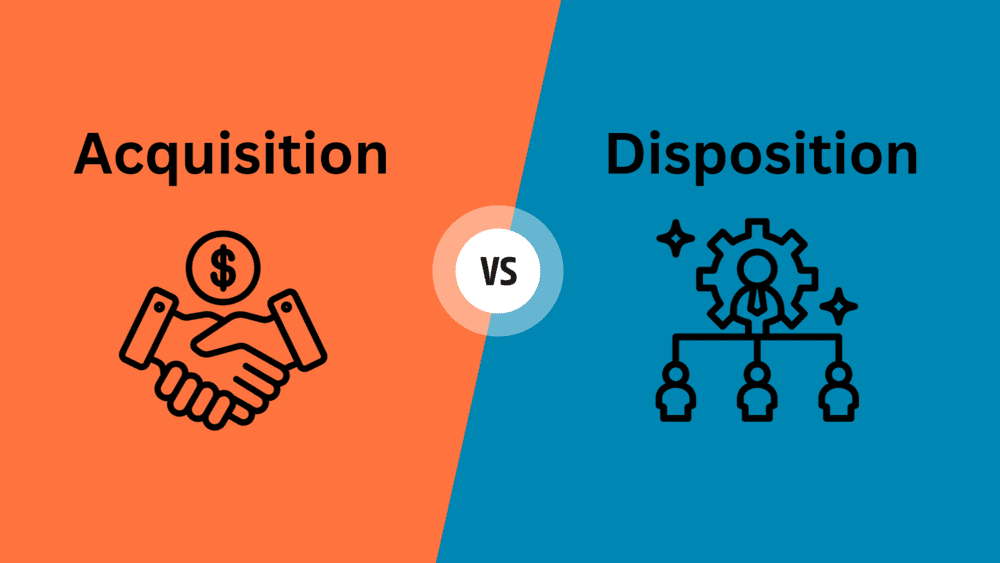Acquisition and disposition are two different business concepts used to achieve long-term goals.
Today’s post will discuss the acquisition, disposition, and difference between these terms.
Acquisition
Acquisition is gaining control over assets, businesses, or properties. Organizations undertake a strategic move to expand their operations, increase market share, or gain access to new resources. Acquisitions are also known as mergers, takeovers, or purchasing of assets.
Acquisition Types
Various acquisition types include:
- Mergers and Acquisitions (M&A): This occurs when two companies combine, usually with one acquiring the other.
- Asset Purchases: This occurs when specific assets are purchased from another entity.
- Stock Purchases: This occurs when controlling interest in a company is acquired by buying its shares.
- Internal Development: This occurs when new organizational assets are created (e.g., building a new factory or developing new software).
Key acquisition reasons include:
- Strategic Growth: This occurs when companies acquire other businesses as part of their growth strategy, thus allowing them to enter new markets, diversify their product/service offerings, and/or achieve economies of scale.
- Market Expansion: This occurs when organizations penetrate new geographical regions, thus reaching a broader customer base and enhancing their overall market presence.
The concept of synergy is often associated with acquisitions. Synergy occurs when the combined entity is more valuable than the sum of its parts. This can lead to cost savings, improved efficiency, and increased competitiveness.
Before completing an acquisition, thorough due diligence is crucial. This involves a comprehensive assessment of the target company’s financial health, operations, legal status, and other relevant factors to ensure that the acquisition aligns with the acquiring company’s goals.
After completing the acquisition, integrating the acquired company into the existing operations is vital. This includes aligning cultures, streamlining processes, and maximizing the benefits of the combined entities.
Disposition
Disposition is selling, divesting, or otherwise disposing of assets or businesses. It is the opposite of acquisition and can be a strategic decision for various reasons, such as focusing on core operations, shedding non-performing assets, or generating cash.
Disposition Types
Similar to acquisitions, dispositions can come in various forms, such as:
- Asset Sales: This occurs when individual assets owned by a company are sold.
- Divestments: This occurs when entire business units or subsidiaries are sold.
- Spin-Offs: This occurs when a new, independent company is created from existing assets.
- Write-offs: This occurs when an asset is recognized as having no or diminished value and removed from the financial statements.
The key reasons for disposition are as follows:
- Strategic Focus: This occurs when companies dispose of certain assets or business units to streamline their operations and concentrate on their core competencies. This can lead to increased efficiency and improved financial performance.
- Financial Optimization: This occurs when underperforming or non-strategic assets are disposed to allow companies to reallocate resources to more profitable areas, thus enhancing overall financial performance.
- Risk Mitigation: This occurs when assets or business units that pose significant risks or liabilities are sold to help companies mitigate potential losses and avoid adverse impacts on their financial stability.
- Cash Generation: This occurs when dispositions are used as cash to pay debts, fund strategic initiatives, or return value to shareholders through dividends or share buybacks.
- Market Changes: This occurs when dispositions are driven by market conditions, industry trends, or shifts in consumer preferences. Companies may choose to exit certain businesses to adapt to evolving market dynamics.
Key Differences Between Acquisitions and Dispositions
While acquisitions and dispositions involve assets, they differ in several key ways, such as:
- Asset-Flow Direction: Acquisitions are an inflow of assets, while dispositions are an outflow.
- Motivation: Acquisitions tend to be driven by growth and strategic aims, while financial or operational needs often trigger dispositions.
- Accounting Treatment: Acquisitions add assets to the balance sheet, while dispositions remove them.
Summary
While acquisitions involve gaining control over assets or businesses to achieve strategic objectives, dispositions involve selling or divesting assets for strategic reasons (e.g., focusing on core operations, mitigating risks, or optimizing financial performance). Acquisitions and dispositions are integral parts of strategic management and business development, as both allow organizations to adapt to changing circumstances and achieve goals.
